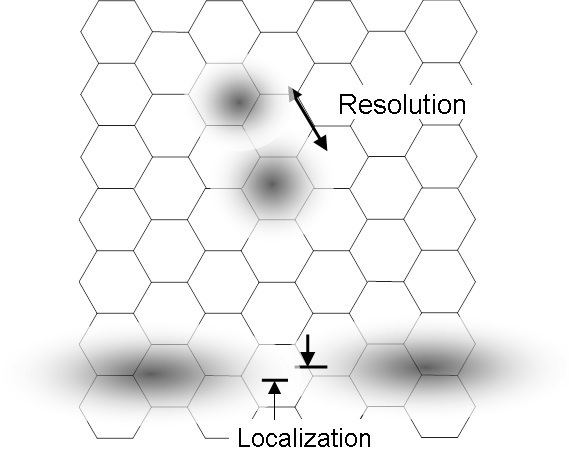 | ||
The sharpness of our senses is defined by the finest detail we can discriminate. Visual acuity is measured by the smallest letters that can be distinguished on a chart and is governed by the anatomical spacing of the mosaic of sensory elements on the retina. Yet spatial distinctions can be made on a finer scale still: misalignment of borders can be detected with a precision up to 10 times better than visual acuity. This hyperacuity, transcending by far the size limits set by the retinal 'pixels', depends on sophisticated information processing in the brain.
Contents
How does hyperacuity differ from traditional acuity?
The best example of the distinction between acuity and hyperacuity comes from vision, for example when observing stars on a night sky. The first stage is the optical imaging of the outside world on the retina. Light impinges on the mosaic of receptor sense cells, rods and cones, which covers the retinal surface without gaps or overlap, just like the detecting pixels in the film plane of digital cameras. Each receptor accepts all the light reaching it but acts as a unit, representing a single location in visual space. This compartmentalization sets a limit to the decision whether an image came from a single or a double star (resolution). For a percept of separately articulated stars to emerge, the images of the two must be wide enough apart to leave at least one intervening pixel relatively unstimulated between them. This defines the resolution limit and the basis of visual acuity.
A quite different mechanism operates in hyperacuity, whose quintessential example and the one for which the word was initially coined, is vernier acuity: alignment of two edges or lines can be judged with a precision five or ten times better than acuity. A sophisticated circuitry in the brain identifies the location of a visual feature by assessing the “center of gravity” of the light over several receptors, a task that can be accomplished with much higher precision than the resolution limit set by the receptor spacing. In computer graphics the phrase “sub-pixel resolution” is sometimes used in discussions of anti-aliasing and geometrical superresolution. Though what is in fact involved is not resolution (is it one or two? – a qualitative distinction) but localization (exactly where? – a quantitative judgment) it captures the process. When an image spreads across several pixels, each with graded intensity response but only a single spatial value, the position of the image center can be located more exactly than the width of the pixel, much like the mean of a histogram can be calculated to a fraction of the bin width.
In the figure on the right, the retinal mosaic has superimposed on it, at top, the images of two stars at resolution limit when the intervening gap assures judgment that there are two stars and not a single elongated one. Shown below are the images of two separate short lines; the precision of the read-out of their location difference transcends the dimension of the mosaic elements.
Analysis of Hyperacuity Mechanism
Details of the neural apparatus for hyperacuity still await discovery. That the hyperacuity apparatus involves signals from a range of individual receptor cells, usually in more than one location of the stimulus space, has implications concerning performance in these tasks. Low contrast, close proximity of neighboring stimuli (crowding), and temporal asynchrony of pattern components are examples of factors that cause performance deficits. Of some conceptual interest are age changes and susceptibility to perceptual learning which can help in understanding underlying neural channeling.
Hyperacuity in Various Sense Modalities
The distinction between resolving power or acuity, literally sharpness, which depends on the spacing of the individual receptors through which the outside world is sampled, and the ability to identify individual locations in the sensory space is universal among modalities. There are many other examples where the organism’s performance substantially surpasses the spacing of the concerned receptor cell population. The normal human has only three kinds of color receptors in the retina, yet in color vision, by subtly weighing and comparing their relative output, one can detect thousand of hues. Braille reading involves hyperacuity among touch receptors in the fingertips. We can hear many more different tones than there are hair cells in the cochlea; pitch discrimination, without which a violin could not be played in tune, is a hyperacuity. Hyperacuity has been identified in many animal species, for example in the detection of prey by the electric fish, echolocation in the bat, and in the ability of rodents to localize objects based on mechanical deformations of their whiskers.
Clinical Applications
In clinical vision tests, hyperacuity has a special place because its processing is at the interfaces of the eye's optics, retinal functions, activation of the primary visual cortex and the perceptual apparatus. In particular, the determination of normal stereopsis is a hyperacuity task. Hyperacuity perimetry is used in clinical trials evaluating therapies for retinal degenerative changes.
